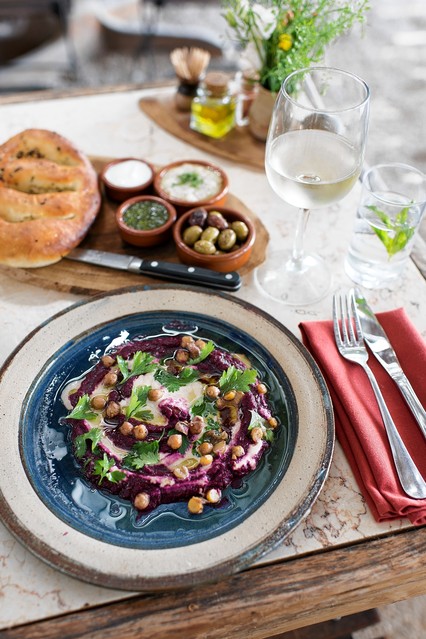 Seeking the best chickpea purée in the city, from the back alleys of the Old City, to the pedestrian malls of West Jerusalem, to the basements of East Jerusalem
Seeking the best chickpea purée in the city, from the back alleys of the Old City, to the pedestrian malls of West Jerusalem, to the basements of East Jerusalem
DON’T TELL A Jerusalemite that hummus is just a side dish. Most locals can agree on one thing: The chickpea purée is no side dish or appetizer. It is the meal’s centerpiece.
While hummus—which means “chickpeas” in Arabic—is a staple throughout the Middle East and parts of North Africa, it often appears alongside other mezze such as tabbouleh or baba ganoush. Not so in Israel and Palestine. Here, a plate of hummus constitutes a perfectly acceptable main meal for breakfast or lunch.
Of course, in this region every cultural marker is a point of contention in some respect. Israel, a nation of Jewish immigrants who bring along their own culinary traditions, has adopted hummus as a de facto national dish. Many Palestinians view that development as yet another example of colonial overreach.
But that doesn’t change the fact that for many locals, this purée is a passion. There are restaurants (“hummusiyot” in Hebrew) dedicated solely to the chickpea dish, and long lines form outside the best. Devotees blog about their quests for the country’s best versions.
“People treat it with awe,” says Janna Gur, author of “The Book of New Israeli Food.” “I’m pretty sure it enjoys such a status nowhere else.”
Great hummus can be found throughout Israel and the Palestinian territories; there are famed restaurants in the coastal locales of Jaffa and Acre, in particular. But Jerusalem offers an unrivaled selection of Arab- and Jewish-owned eateries.
From the back alleys of the Old City to the pedestrian malls of West Jerusalem to the basements of East Jerusalem, the quality of the hummus served here challenges visitors’ notions of how good mashed chickpeas can be. And while hardly any Jerusalemites are in sight at many of the city’s sacred sites, at hummus restaurants, travelers can rub elbows with locals while getting sustenance for sightseeing at the same time.
Containing few main ingredients—chickpeas, the sesame paste known as tahini, olive oil, lemon juice and garlic—hummus would seem like a straightforward affair. It isn’t. Proportions matter, as does the quality of ingredients. Good chickpeas are obviously crucial, and some chefs have gone so far as to require that their beans be picked at a precise time of day.
One can hardly speak of West Jerusalem and East Jerusalem hummus styles, but small differences do exist. Hummus served in the eastern, Palestinian part of the city tends to be more “clean, without spices and a little heavy,” said Limor Laniado Tiroche, a chef and food columnist for the Haaretz newspaper, via email. West Jerusalem’s hummus is often less oily, slightly crunchier and more likely to feature toppings such as eggs or mushrooms.
“Some with a nonliteral bent see the dip in a Bible verse.”
The origins of hummus are unknown, though the dish is thought to be very old. Some with a nonliteral bent see its presence in a Bible verse, Ruth 2:14—”At mealtime Boaz said to her, ‘Come over here. Have some bread and dip it in the wine vinegar'”—noting that the words for “wine vinegar” and “chickpeas” are similar in Hebrew.
Hummus is generally served with pita bread and falafel as well as raw onions, pickles and tomatoes to scoop up the revered dish. Individual servings may look small, but they are filling. Inbal Baum, who leads hummus tours in Tel Aviv, said she instructs participants to pace themselves and share plates.
Attempts at modernizing hummus haven’t gone very far. Most have involved adding toppings to the mix, but Tomer Niv, chef at Rama’s Kitchen, a hilltop restaurant outside Jerusalem that prizes local ingredients, is happily breaking the rules. Mr. Niv makes a beet-based hummus in which chickpeas are almost an afterthought.
“The hummus is the technique, not the ingredient,” he said. The chef is experimenting with other ingredients, including pumpkin, carrots and sweet potatoes, he said.
“Until now, chefs are not really wanting to mess with the dish because it is good as it is,” Ms. Tiroche said. “And everyone agrees with that.”
For a complete list of recommended restaurants in Jerusalem, and the original WSJ post, click here.
By NICOLAS BRULLIARD
Courtesy of The Wall Street Journal
Photography by Laurent Burst for Rama’s Kitchen











